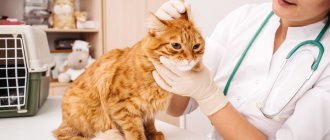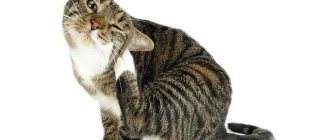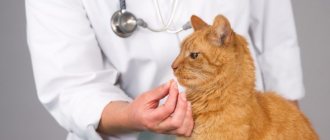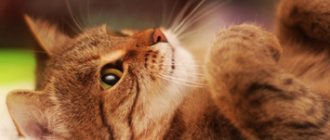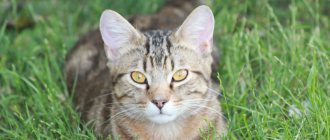Cat breeders are very sensitive to the health of their pets' teeth, since high demands are placed on their condition at exhibitions. However, you need to take care of your teeth not only for the sake of victories and breeding, but for the sake of the health of the animal’s oral cavity and the entire body as a whole. Dental problems have a very bad effect on the well-being of purring pets, and tartar in cats is one of the most common and serious of them.
Content
1. How to recognize a cat’s tendency to this disease? 2. Tartar in cats: symptoms and consequences 3. How to remove tartar in a cat 4. How to treat tartar in a cat? 5. Removing tartar from a cat at home 6. Prevention of tartar in cats
Tartar in cats is a very insidious disease that can occur completely unnoticed by the owners in the initial stages. It is extremely difficult to identify a problem at an early stage, but it is even more difficult to correctly prevent its occurrence.
As a rule, tartar in a cat is formed as a result of insufficiently thorough, irregular oral hygiene. The consequence of this is the appearance of an animal-like foul odor in the mouth, as well as painful sensations when chewing food. If you ignore this problem for too long, your beloved pet may lose its teeth completely. To prevent this from happening, you should stock up on at least basic knowledge about this dangerous disease.
Tartar is a dense, hard plaque that accumulates due to the vigorous activity of microorganisms. The accumulation of lime is rough to the touch and has a cloudy brown color. This problem is mainly observed in pets under one year of age. At an early stage of development, tartar accumulates as a result of the accumulation of pathogenic microorganisms on the surface of the animal’s fangs. As a result, the teeth are affected by hard particles that grow over time.
The main prerequisites for the formation of tartar in cats include:
- presence of rotten teeth;
- inflammatory processes affecting the gingival mucosa;
- absence of at least one antagonist tooth;
- impaired metabolism of minerals (leads to an imbalance of phosphorus and calcium).
Veterinarians also name several factors that increase the risk of developing the disease:
- wrong choice of cat food;
- lack of solid natural food in the animal’s diet that can remove plaque naturally;
- irregular and insufficiently thorough oral hygiene of the pet (or its absence in principle).
Reasons for fossils
Dental problems can be caused by the following factors:
- lack of timely hygienic treatment of the oral cavity;
- trauma, extensive deep caries, gum damage;
- the absence of a neighboring tooth on the opposite jaw, which provides friction when chewing food;
- malocclusion or curvature of the jaw bones;
- metabolic disorders in the animal's body;
- incorrectly selected diet;
- drinking tap water.
If your cat is at risk, do not neglect preventive visits to your veterinarian.
How to recognize a cat’s tendency to this disease?
If previously tartar was considered a disease characteristic of older cats, today it is increasingly detected in young animals. Most experts believe that the reason for this trend is an unbalanced diet, which leads to disruption of many metabolic processes.
Veterinarians identify risk groups that include certain breeds of cats that are susceptible to developing tartar. The owners of the Persians, British and Scots should be wary. The tendency to this disease among the named breeds is caused by the negligent attitude of low-skilled breeders towards their gene pool.
Semi-feral and barn cats, accustomed to eating exclusively natural food, are much less susceptible to the formation of tartar and other oral diseases. The reason for this is a much stable immunity compared to purebred relatives.
However, it is possible to protect your pet from such an unpleasant problem. The most important thing is to be careful and not delay visiting the veterinarian at the first suspicion that your animal has this disease.
Risk group
The Murkoshi team points out that there are features that increase the chance of dental plaque in some cats. This:
- Metabolic disorders - excess salts and trace elements in saliva lead to accelerated layering and hardening of plaque. Congenital pathology.
- Malocclusion is a congenital phenomenon; the deposits cannot be removed by natural friction of the teeth.
- Increased enamel roughness is an individual feature.
- Popular breeds - Siamese, Persian, British Fold and Scottish - are generally prone to disease (which does not mean that any member of one of these breeds will necessarily be predisposed to disease).
Tartar in cats: symptoms and consequences
The most common manifestations of the disease include:
- the presence of a foul odor from the cat’s mouth;
- growths on the surface of the fangs, the origin of which is unknown;
- frequent inflammation of the gums;
- hot temper, aggressiveness, frequent growling of the animal and other manifestations of behavior unusual for a cat;
- intense secretion of saliva;
- unstable and loose teeth that are prone to falling out;
- the cat's tendency to rub its cheek on any surface;
- visible plaque on the teeth that is yellow or brownish in color;
- swelling of the oral mucosa;
- swelling of the eyelids;
- loss of appetite.
To effectively remove tartar, the owner needs to take the pet to the veterinarian. Only a specialist, after a thorough examination of the animal’s oral cavity, can determine the nature and stage of development of the disease. Refusal to visit a specialist and qualified treatment can lead to serious complications of dental plaque, namely:
- initial stage of periodontal disease (gingivitis);
- infectious lesions of the gums, fraught with tooth loss (periodontal disease);
- inflammatory processes that cause unbearable pain in the animal (pulpitis);
- bacterial infection of the teeth and oral cavity (stomatitis).
Symptoms
If you notice the following symptoms in your pet, contact your veterinarian immediately:
- the cat constantly shakes its head, as if trying to independently free itself from some foreign body;
- a strong unpleasant smell of rotting emanates from the mouth;
- soreness, redness, bleeding gums;
- brown and yellow deposits on teeth;
- the cat eats little, shows anxiety, or completely refuses food due to painful sensations similar to pulpitis.
Neglected cases lead to caries, gingivitis, stomatitis, periodontal disease, as well as diseases of the nasolacrimal ducts and ears.
How to remove tartar from a cat
Removing tartar from a cat is a procedure that causes significant discomfort to the animal. In the absence of complications, the process takes from 40 minutes to an hour. In most cases, veterinary clinics offer step-by-step teeth cleaning, which ensures the highest quality removal of growths. It is extremely important to address this problem to a reliable clinic with high-class specialists. If cleaning is not done thoroughly enough, re-formation of tartar on the teeth cannot be avoided.
Tartar can be removed from a cat using special dental devices and equipment.
Currently practiced:
- ultrasonic stone removal (effective for removing small plaque particles);
- treatment of teeth with grinding and polishing pastes.
Owners of old and weakened pets who are unable to confidently tolerate general anesthesia should prepare for multi-stage treatment of the animal under the influence of painkillers. In this case, cleaning tartar in cats is carried out gradually, which will require more than one visit to the veterinarian.
Elimination of plaque does not at all indicate that the treatment has come to an end. Remember: even after complete removal of tartar, your pet will still need care. Your veterinarian will provide recommendations regarding pain medications that you can give your cat on your own. You should also temporarily replace your usual solid foods with semi-liquid ones.
How to treat tartar in a cat?
In large cities, most veterinary clinics have equipment designed for ultrasonic plaque removal. This method of treatment is expensive and requires the animal to be placed under general anesthesia (alternatively, medicated sleep).
In the absence of the necessary equipment, clinics practice a simpler method of treatment - removing tartar using special dental instruments. This technique can be stressful for the animal: the cat must be well secured in a comfortable position, and then anesthesia must be applied. Not every pet is able to withstand a painful procedure.
Before the procedure, the gum edge and teeth are isolated from saliva using a cotton swab soaked in an iodine solution. Small growths are treated with lactic acid and removed mechanically after some time. To do this, the veterinarian uses a special brush soaked in a sodium bicarbonate solution.
Removing tartar from a cat at home
When owners are not sure that they are ready to subject their pet to severe stress when visiting a veterinary clinic, they can choose a more affordable way to solve the problem - treating the plaque themselves at home. For this purpose, a special product is used - “Tropicline”.
This gel contains only natural ingredients, the action of which is aimed at quickly removing growths from the teeth. Despite the availability of the method, it will require special patience and considerable effort from the owners. The gel is used daily for a month, half an hour after the animal eats food. The standard dosage of the gel is no more than 2 drops.
After treating the teeth, any remaining product must be removed immediately by thoroughly brushing your pet’s teeth. For the greatest effectiveness of the method and consolidation of the result, experts recommend carrying out such cleaning twice a week.
Prevention of tartar in cats
To protect your beloved pet from such a scourge, you should follow a number of recommendations to prevent the formation of dental plaque:
- First of all, make it a habit to regularly brush your cat's teeth and mouth. Your pet needs to be taught proper hygiene from a very early age. As practice shows, it is much easier for a kitten to get used to this procedure than for an adult animal.
- The basis of healthy and beautiful teeth is a balanced diet. You should carefully select dry food for your pet: veterinarians advise choosing those that contain dietary fiber. The latter have a beneficial effect on the surface of the teeth and cleanse them of plaque in a natural way.
- It would also be a good idea to have food in the house that contains polyphosphate, a component that creates a protective film on the teeth. Periodic consumption of such food will serve as an effective prevention of plaque formation.
- Take your pet to the veterinarian promptly. Even if there are no symptoms of tartar, an examination of the oral cavity should be carried out at least once every 2 months.
- Make sure your cat gets enough vitamins and minerals from its diet.
Share this article on social networks
Prevention
Acute toothache is considered the most severe after childbirth. Therefore, so that your pet does not have to experience it, you need to take the following preventive measures:
- Teeth cleaning
It is recommended to use special toothpastes with different flavors and brushes. There are regular and massage brushes, alternate between them.
Read more: How to brush your cat's teeth
- Balanced diet
The optimal choice is professional super-premium and holistic-class food. Not only will they not harm your pet (unlike cheap food), but they will also provide him with all the necessary vitamins and minerals. At the Murkosha shelter, cats receive exactly this kind of food.
Read about food: What food to feed your cat
You can also purchase dried tendons for cleaning your teeth.
- Treatment of gastrointestinal diseases
They disrupt the acid-base balance of the oral cavity.
- Preventative visit to the veterinarian
At a minimum, this should be done once a year, preferably every six months (and if the pet is over 10 years old, then it is mandatory).
More information about a planned visit to the doctor: Annual visit to the veterinarian - what is included and why it is needed


